A Deep Learning Method for the Prediction of Pollutant Emissions from Internal Combustion Engines
Abstract
1. Introduction
Present Contribution
2. Materials and Methods
2.1. Experimental Setup
2.2. Artificial Neural Network Setup
2.2.1. Description of the Initial Dataset
- Engine speed [rpm].
- Ignition timing [CAD aTDC].
- Throttle valve opening [%].
- Torque [Nm].
2.2.2. Description of the Dynamic Cycles
3. Developing and Optimization of the Artificial Neural Network
3.1. Back Propagation Structure
- Learning rate, which controls the pace of learning.
- Overfitting, in which the network exhibits strong performance on training data but struggles with unseen data, a challenge that can be mitigated using techniques such as regularization.
- Convergence, where training stabilizes as the network learns optimal weights.
3.2. Overview of the Procedures for Establishing the Structural Parameters of the Proposed Model
- N = cycle duration.
- i = ith temporal instant.
- = predicted value.
- = target value (experimental results).
4. Results and Discussion
- rMSE is the relative mean squared error.
- is the mean squared error.
- Var() refers to the variance of the random variable . Variance is a statistical measure that represents the dispersion or spread of the values of around its mean. It quantifies how much the values of x deviate from the mean value .
5. Conclusions
Author Contributions
Funding
Institutional Review Board Statement
Informed Consent Statement
Data Availability Statement
Conflicts of Interest
Nomenclature
| ANN | artificial neural network |
| aBDC | after bottom dead center |
| aTDC | after top dead center |
| BP | back propagation |
| BPANN | back propagation artificial neural network |
| CAD | crank angle degree |
| CO | carbon monoxide |
| CO2 | carbon dioxide |
| CoVIMEP | coefficient of variance of IMEP |
| CPU | central processing unit |
| DI | direct injection |
| DPF | diesel particulate filter |
| E5 | gasoline |
| E20/E85 | ethanol |
| ECU | engine control unit |
| EGR | exhaust gas recirculation |
| ELSB | ensemble least-squares boosting |
| GHG | greenhouse gasses |
| GPF | gasoline particulate filter |
| H2 | hydrogen |
| HC | hydrocarbons |
| IC | internal combustion |
| IMEP | indicated mean effective pressure |
| IT | ignition timing |
| λ (1/φ) | air excess coefficient |
| LTC | low-temperature combustion |
| M100 | methanol |
| MAPE | mean average percentage error |
| MLP | Multi-Layer Perceptron |
| ML | machine learning |
| MON | Motor Octane Number |
| NOx | nitrogen oxides |
| O2 | oxygen |
| PFI | port fuel injection |
| R2 | coefficient of determination |
| RAM | Random Access Memory |
| RBF | Radial Basis Function |
| SCR | selective catalytic reducer |
| RMSE | root mean square error |
| RON | Research Octane Number |
| TPRF | Toluene Primary Reference Fuel |
| TVO | throttle valve opening |
References
- Joshi, A. Review of vehicle engine efficiency and emissions. SAE Int. J. Adv. Curr. Pract. Mobil. 2020, 2, 2479–2507. [Google Scholar] [CrossRef]
- Suresh, D.; Porpatham, E. Influence of high compression ratio and hydrogen addition on the performance and emissions of a lean burn spark ignition engine fueled by ethanol-gasoline. Int. J. Hydrogen Energy 2023, 48, 14433–14448. [Google Scholar] [CrossRef]
- Reitz, R.D.; Ogawa, H.; Payri, R.; Fansler, T.; Kokjohn, S.; Moriyoshi, Y.; Agarwal, A.; Arcoumanis, D.; Assanis, D.; Bae, C.; et al. IJER editorial: The future of the internal combustion engine. Int. J. Engine Res. 2020, 21, 3–10. [Google Scholar] [CrossRef]
- Wallington, T.J.; Anderson, J.E.; Dolan, R.H.; Winkler, S.L. Vehicle emissions and urban air quality: 60 years of progress. Atmosphere 2022, 13, 650. [Google Scholar] [CrossRef]
- Berggren, C.; Magnusson, T. Reducing automotive emissions—The potentials of combustion engine technologies and the power policy. Energy Policy 2012, 41, 636–643. [Google Scholar] [CrossRef]
- Kalghatgi, G.; Johansson, B. Gasoline compression ignition approach to efficient, clean and affordable future engines. Proc. Inst. Mech. Eng. Part D J. Automob. Eng. 2018, 232, 118–138. [Google Scholar] [CrossRef]
- Dernotte, J.; Najt, P.M.; Durrett, R.P. Downsized-Boosted Gasoline Engine with Exhaust Compound and Dilute Advanced Combustion. SAE Int. J. Adv. Curr. Pract. Mobil. 2020, 2, 2665–2680. [Google Scholar] [CrossRef]
- Arabaci, E.; İçingür, Y.; Solmaz, H.; Uyumaz, A.; Yilmaz, E. Experimental investigation of the effects of direct water injection parameters on engine performance in a six-stroke engine. Energy Convers. Manag. 2015, 98, 89–97. [Google Scholar] [CrossRef]
- Lutkemeyer, G.; Weinowski, R.; Lepperhoff, G.; Brogan, M.S.; Brisley, R.J.; Wilkins, A.J.J. Comparison of De-Nox and Adsorber Catalysts to Reduce NOx Emission of Lean Burn Gasoline Engine; SAE Technical Paper 962046; SAE International: Warrendale, PA, USA, 1996; p. 962046. [Google Scholar]
- Dadam, S.R.; Jentz, R.; Lenzen, T.; Meissner, H. Diagnostic Evaluation of Exhaust Gas Recirculation (EGR) System on Gasoline Electric Hybrid Vehicle; SAE Technical Paper 2020-01-0902; SAE International: Warrendale, PA, USA, 2020. [Google Scholar]
- Singh, A.P.; Kumar, V.; Agarwal, A.K. Evaluation of comparative engine combustion, performance and emission characteristics of low temperature combustion (PCCI and RCCI) modes. Appl. Energy 2020, 278, 115644. [Google Scholar] [CrossRef]
- Pielecha, J.; Skobiej, K.; Kurtyka, K. Exhaust emissions and energy consumption analysis of conventional, hybrid, and electric vehicles in real driving cycles. Energies 2020, 13, 6423. [Google Scholar] [CrossRef]
- Anika, O.C.; Nnabuife, S.G.; Bello, A.; Okoroafor, E.R.; Kuang, B.; Villa, R. Prospects of low and zero-carbon renewable fuels in 1.5-degree net zero emission actualization by 2050: A critical review. Carbon Capture Sci. Technol. 2022, 5, 100072. [Google Scholar] [CrossRef]
- Martinelli, R.; Ricci, F.; Zembi, J.; Battistoni, M.; Grimaldi, C.; Papi, S. Lean Combustion Analysis of a Plasma-Assisted Ignition System in a Single Cylinder Engine fueled with E85; SAE Technical Paper 2022-24-0034; SAE International: Warrendale, PA, USA, 2022. [Google Scholar]
- Ricci, F.; Zembi, J.; Avana, M.; Grimaldi, C.N.; Battistoni, M.; Papi, S. Analysis of Hydrogen Combustion in a Spark Ignition Research Engine with a Barrier Discharge Igniter. Energies 2024, 17, 1739. [Google Scholar] [CrossRef]
- Duan, X.; Xu, L.; Xu, L.; Jiang, P.; Gan, T.; Liu, H.; Ye, S.; Sun, Z. Performance analysis and comparison of the spark ignition engine fueled with industrial by-product hydrogen and gasoline. J. Clean. Prod. 2023, 424, 138899. [Google Scholar] [CrossRef]
- Cervantes-Bobadilla, M.; García-Morales, J.; Saavedra-Benítez, Y.I.; Hernández-Pérez, J.A.; Adam-Medina, M.; Guerrero-Ramírez, G.V.; Escobar-Jímenez, R.F. Multiple fault detection and isolation using artificial neural networks in sensors of an internal combustion engine. Eng. Appl. Artif. Intell. 2023, 117, 105524. [Google Scholar] [CrossRef]
- Antinyan, V. Revealing the complexity of automotive software. In Proceedings of the 28th ACM Joint Meeting on European Software Engineering Conference and Symposium on the Foundations of Software Engineering, Virtual Event, 8–13 November 2020; pp. 1525–1528. [Google Scholar]
- Khurana, S.; Saxena, S.; Jain, S.; Dixit, A. Predictive modeling of engine emissions using machine learning: A review. Mater. Today Proc. 2021, 38, 280–284. [Google Scholar] [CrossRef]
- Huang, G.; Fukushima, E.F.; She, J.; Zhang, C.; He, J. Estimation of sensor faults and unknown disturbance in current measurement circuits for PMSM drive system. Measurement 2019, 137, 580–587. [Google Scholar] [CrossRef]
- Abu-Nabah, B.A.; ElSoussi, A.O.; Abed, E.K.; Alami, A.l. Virtual laser vision sensor environment assessment for surface profiling applications. Measurement 2018, 113, 148–160. [Google Scholar] [CrossRef]
- Bai, S.; Li, M.; Lu, Q.; Fu, J.; Li, J.; Qin, L. A new measuring method of dredging concentration based on hybrid ensemble deep learning technique. Measurement 2022, 188, 110423. [Google Scholar] [CrossRef]
- Le Cornec, C.M.A.; Molden, N.; van Reeuwijk, M.; Stettler, M.E.J. Modelling of instantaneous emissions from diesel vehicles with a special focus on NOx: Insights from machine learning techniques. Sci. Total Environ. 2020, 737, 139625. [Google Scholar] [CrossRef] [PubMed]
- Moradi, M.H.; Heinz, A.; Wagner, U.; Koch, T. Modeling the emissions of a gasoline engine during high-transient operation using machine learning approaches. Int. J. Engine Res. 2022, 23, 1708–1716. [Google Scholar] [CrossRef]
- Khac, H.N.; Modabberian, A.; Zenger, K.; Niskanen, K.; West, A.; Zhang, Y.; Silvola, E.; Lendormy, E.; Storm, X.; Mikulski, M. Machine Learning Methods for Emissions Prediction in Combustion Engines with Multiple Cylinders. IFAC-PapersOnLine 2023, 56, 3072–3078. [Google Scholar] [CrossRef]
- Godwin, D.J.; Varuvel, E.G.; Martin, M.L.J. Prediction of combustion, performance, and emission parameters of ethanol powered spark ignition engine using ensemble Least Squares boosting machine learning algorithms. J. Clean. Prod. 2023, 421, 138401. [Google Scholar] [CrossRef]
- Cui, Y.; Liu, H.; Wang, Q.; Zheng, Z.; Wang, H.; Yue, Z.; Ming, Z.; Wen, M.; Feng, L.; Yao, M. Investigation on the ignition delay prediction model of multi-component surrogates based on back propagation (BP) neural network. Combust. Flame 2022, 237, 111852. [Google Scholar] [CrossRef]
- Wright, L.G.; Onodera, T.; Stein, M.M.; Wang, T.; Schachter, D.T.; Hu, Z.; McMahon, P.L. Deep physical neural networks trained with backpropagation. Nature 2022, 601, 549–555. [Google Scholar] [CrossRef]
- Wang, Z.; Feng, K. NOx Emission Prediction for Heavy-Duty Diesel Vehicles Based on Improved GWO-BP Neural Network. Energies 2024, 17, 336. [Google Scholar] [CrossRef]
- Petrucci, L.; Ricci, F.; Mariani, F.; Cruccolini, V.; Violi, M. Engine Knock Evaluation Using a Machine Learning Approach; SAE Technical Paper 2020-24-0005; SAE International: Warrendale, PA, USA, 2020. [Google Scholar]
- Petrucci, L.; Ricci, F.; Mariani, F.; Mariani, A. From real to virtual sensor, an artificial intelligence approach for the industrial phase of end-of-line quality control of GDI pumps. Measurements 2022, 199, 111583. [Google Scholar] [CrossRef]
- Petrucci, L.; Ricci, F.; Mariani, F.; Discepoli, G. A development of a new image analysis technique for detecting the flame front evolution in spark ignition engine under lean condition. Vehicles 2022, 4, 145–166. [Google Scholar] [CrossRef]
- Irimescu, A.; Tornatore, C.; Marchitto, L.; Merola, S.S. Compression Ratio and Blow-by Rates Estimation Based on Motored Pressure Trace Analysis for an Optical Spark Ignition Engine. Appl. Therm. Eng. 2013, 61, 101–109. [Google Scholar] [CrossRef]
- Merola, S.S.; Irimescu, A.; Tornatore, C.; Valentino, G. Effect of the Fuel-Injection Strategy on Flame-Front Evolution in an Optical Wall-Guided DISI Engine with Gasoline and Butanol Fueling. J. Energy Eng. 2016, 142, E4015004. [Google Scholar] [CrossRef]
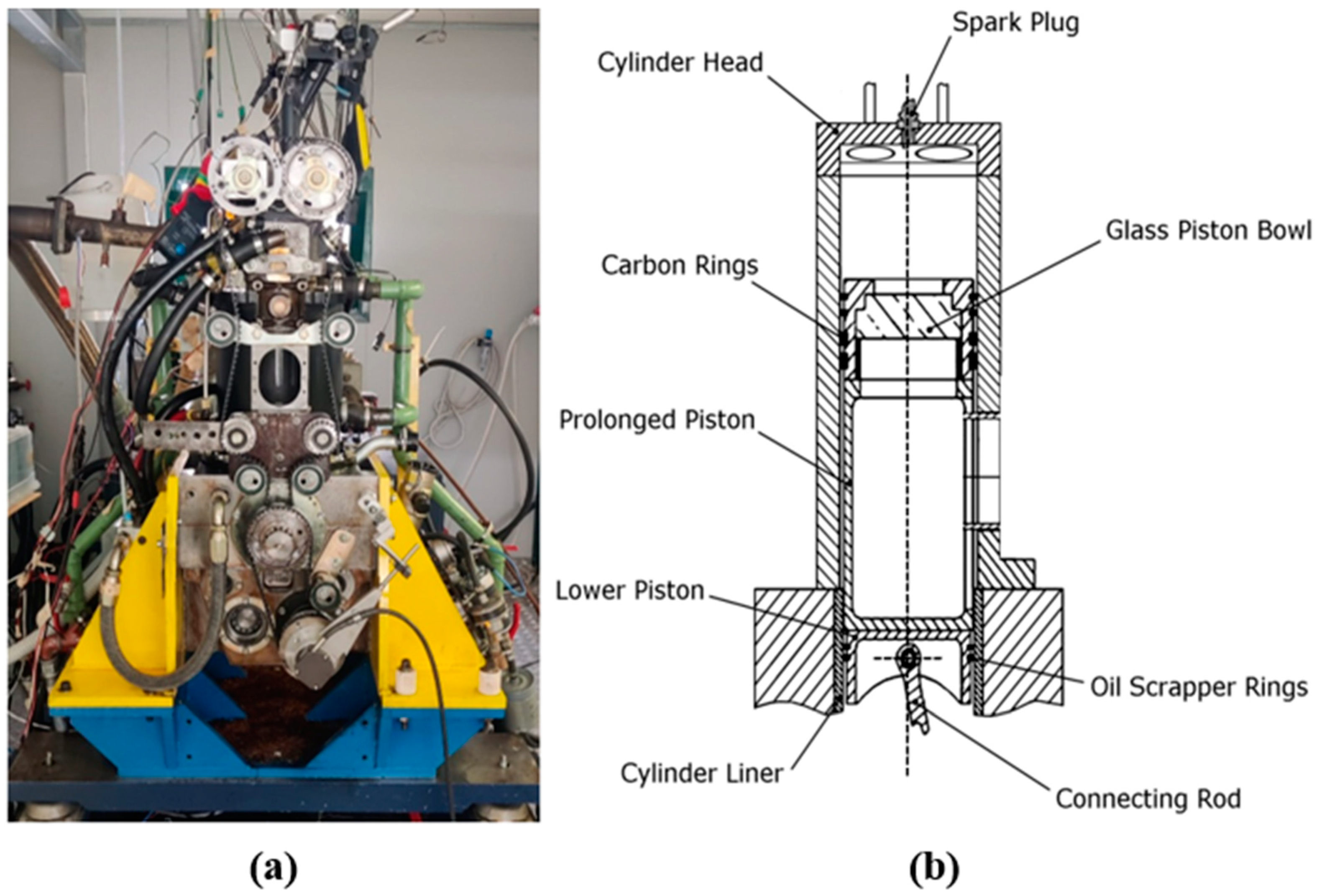
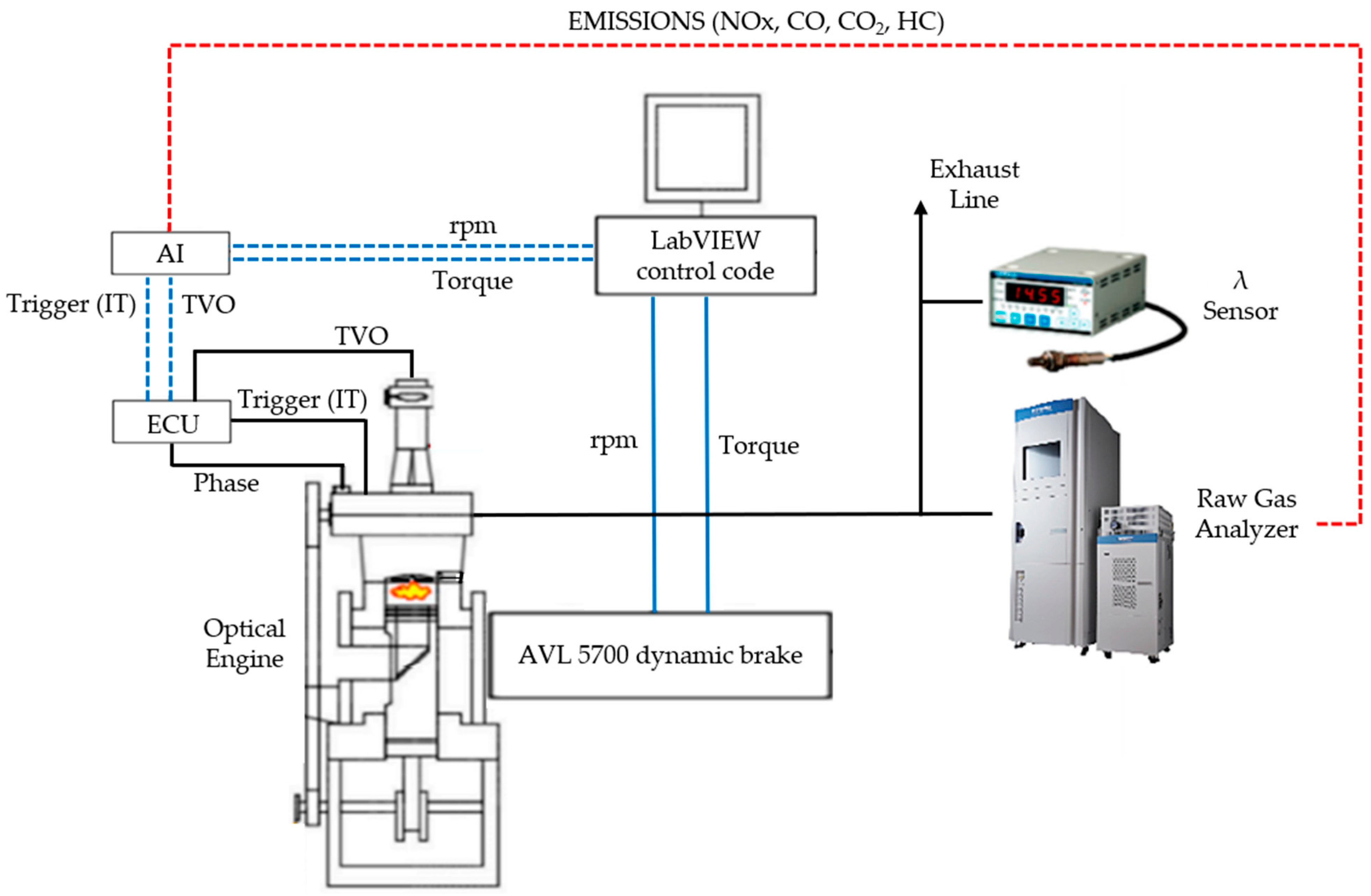
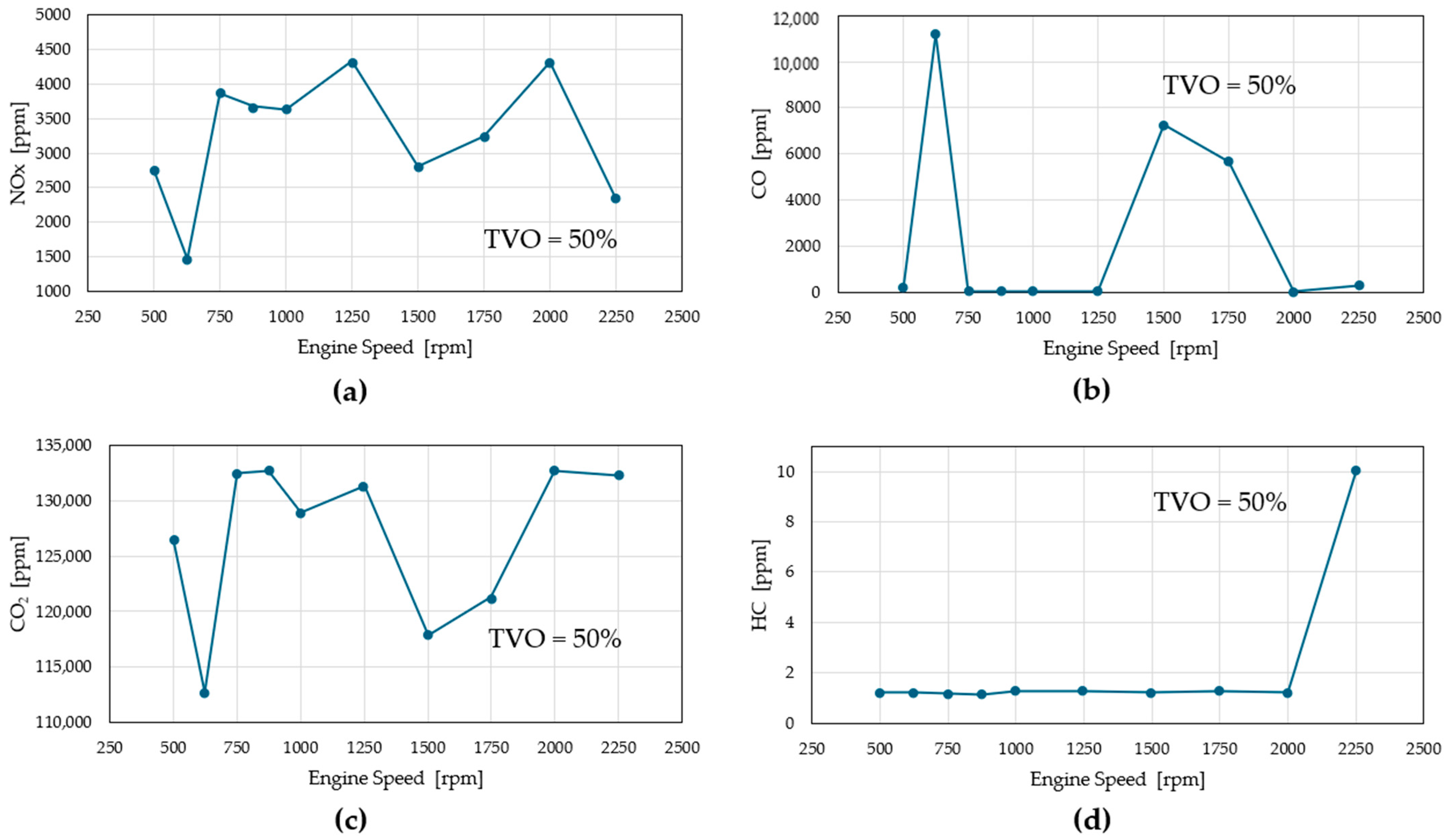

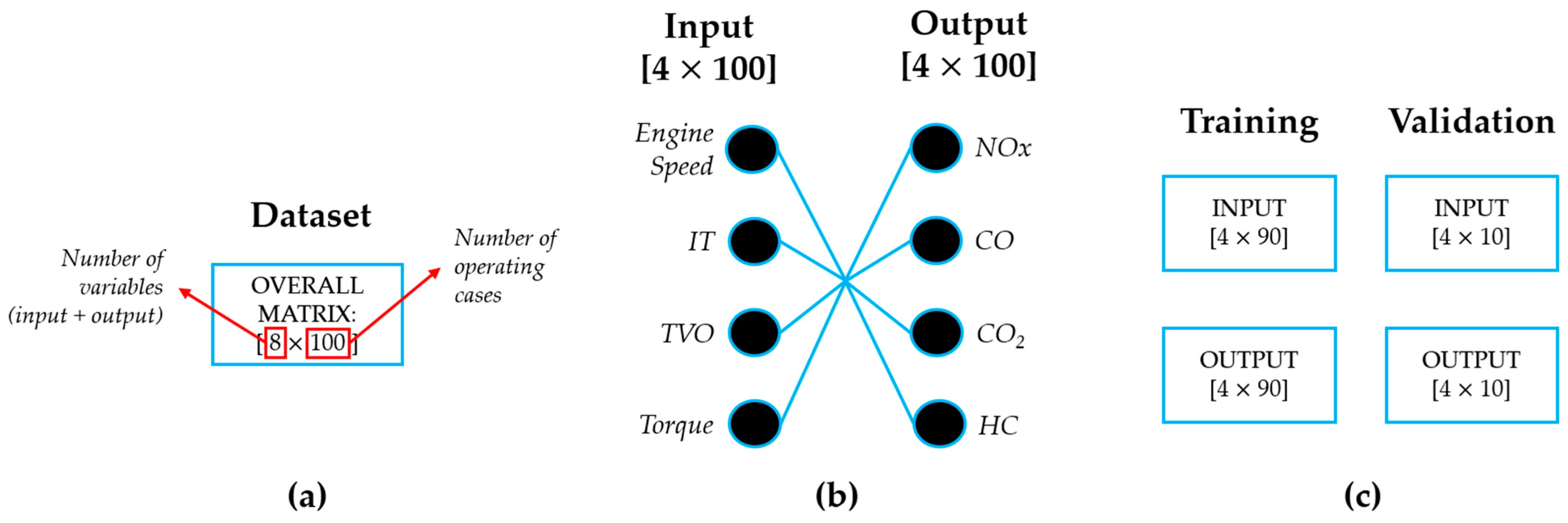
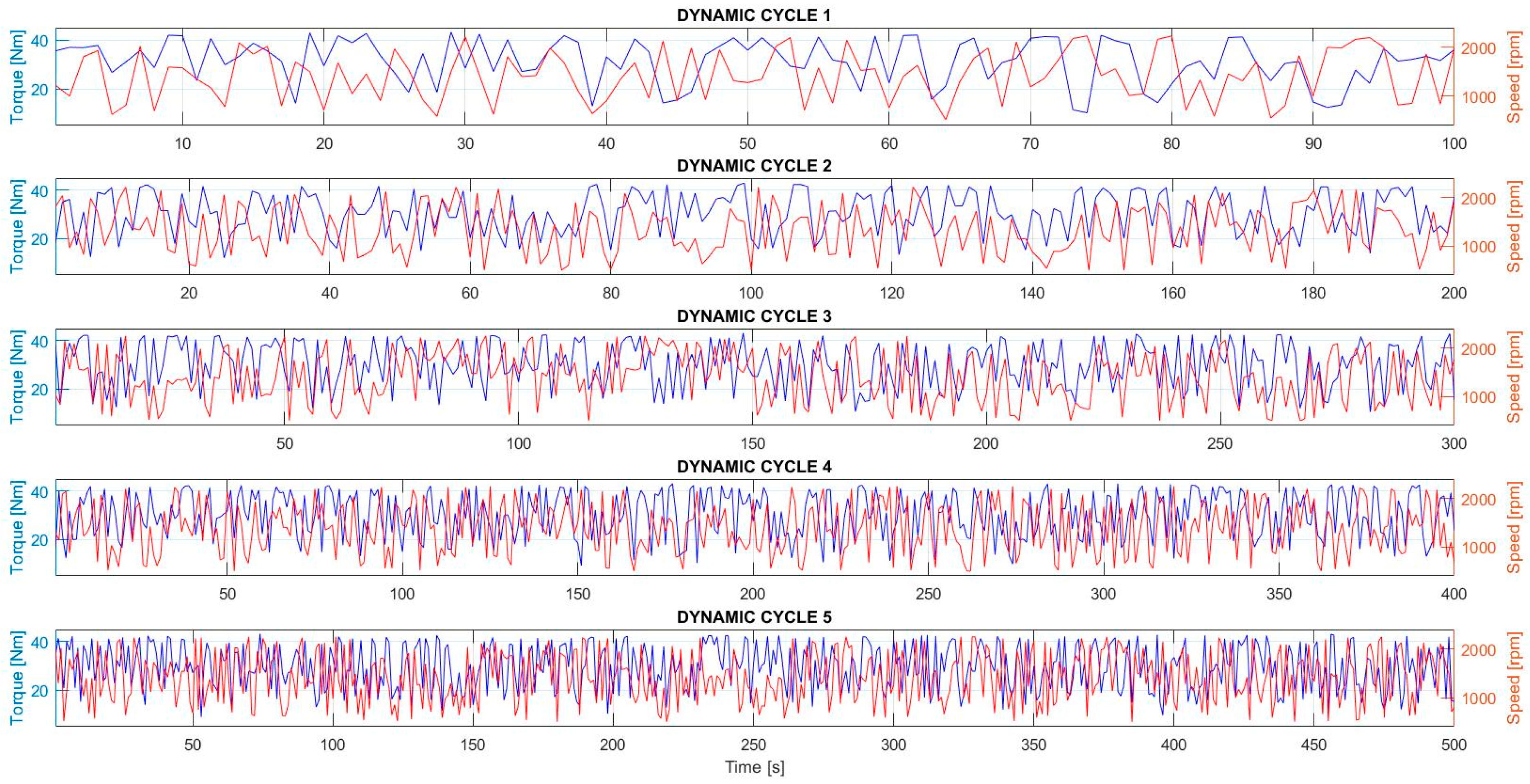
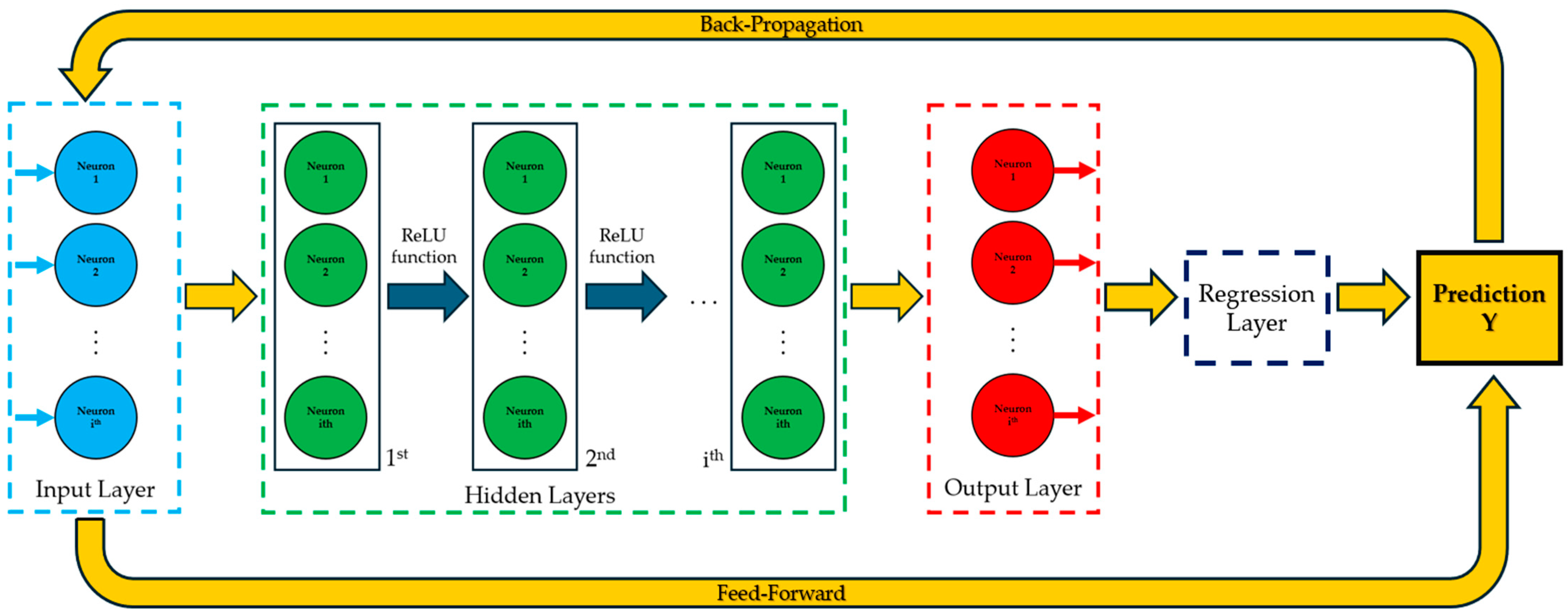
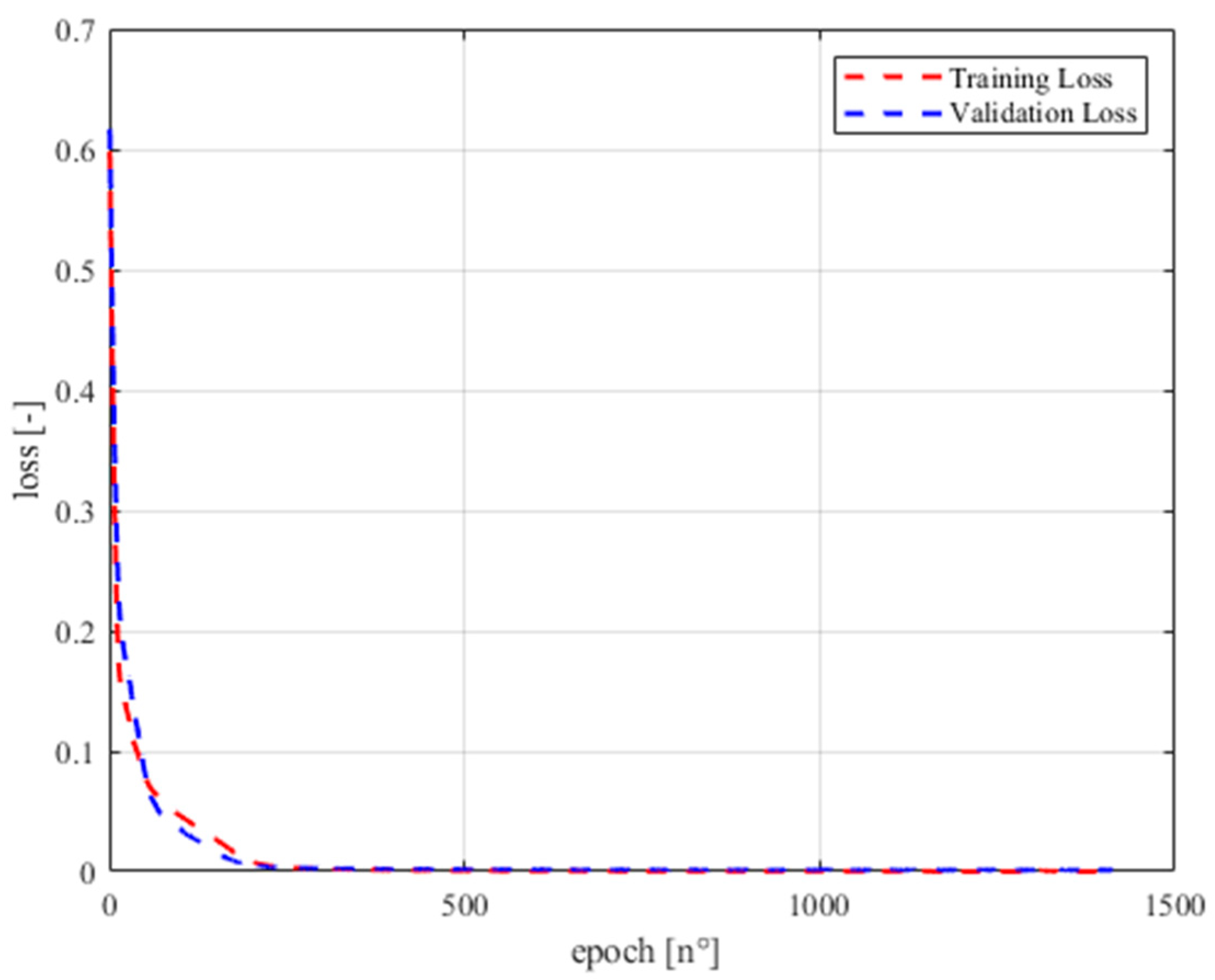
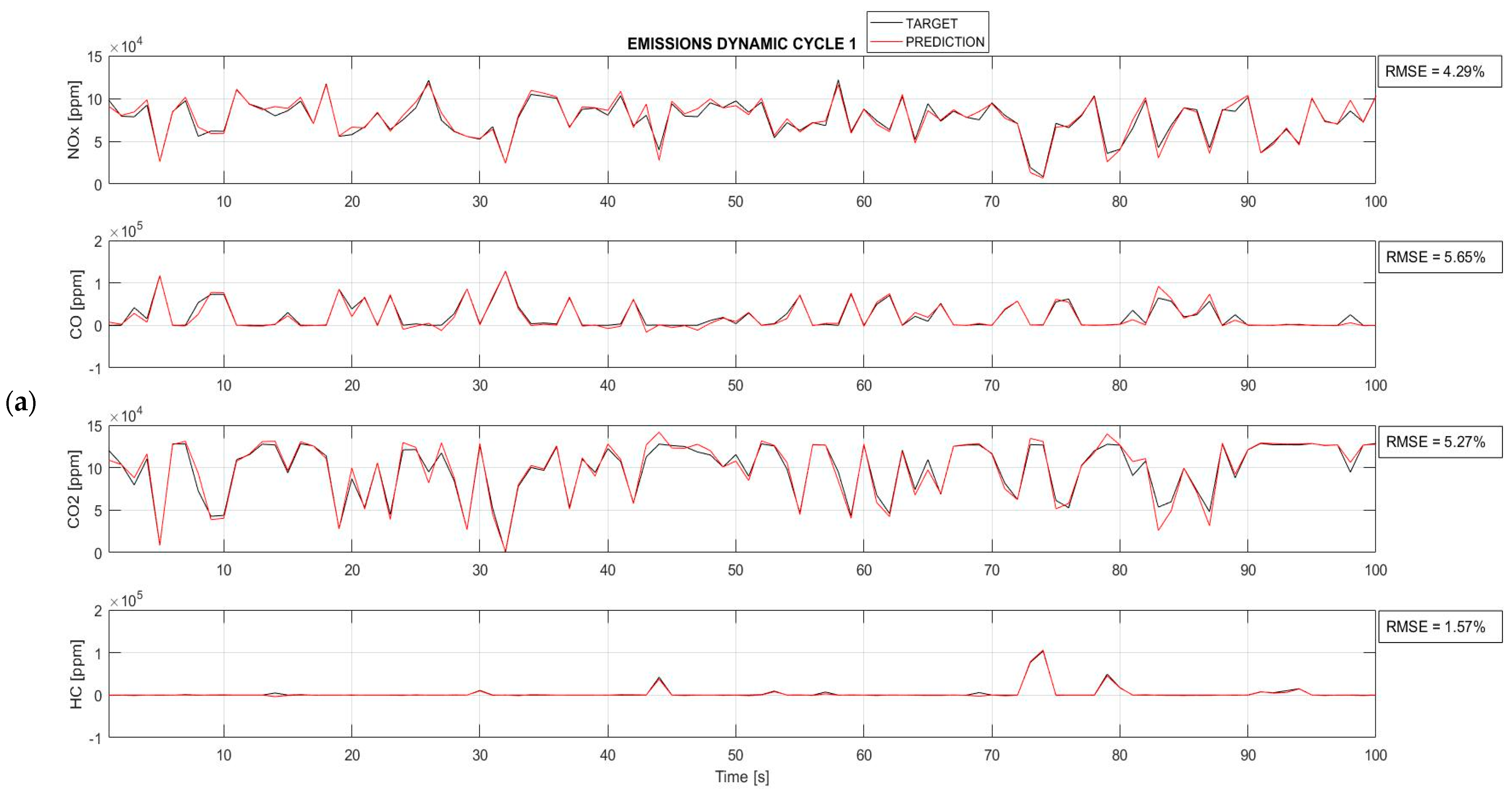
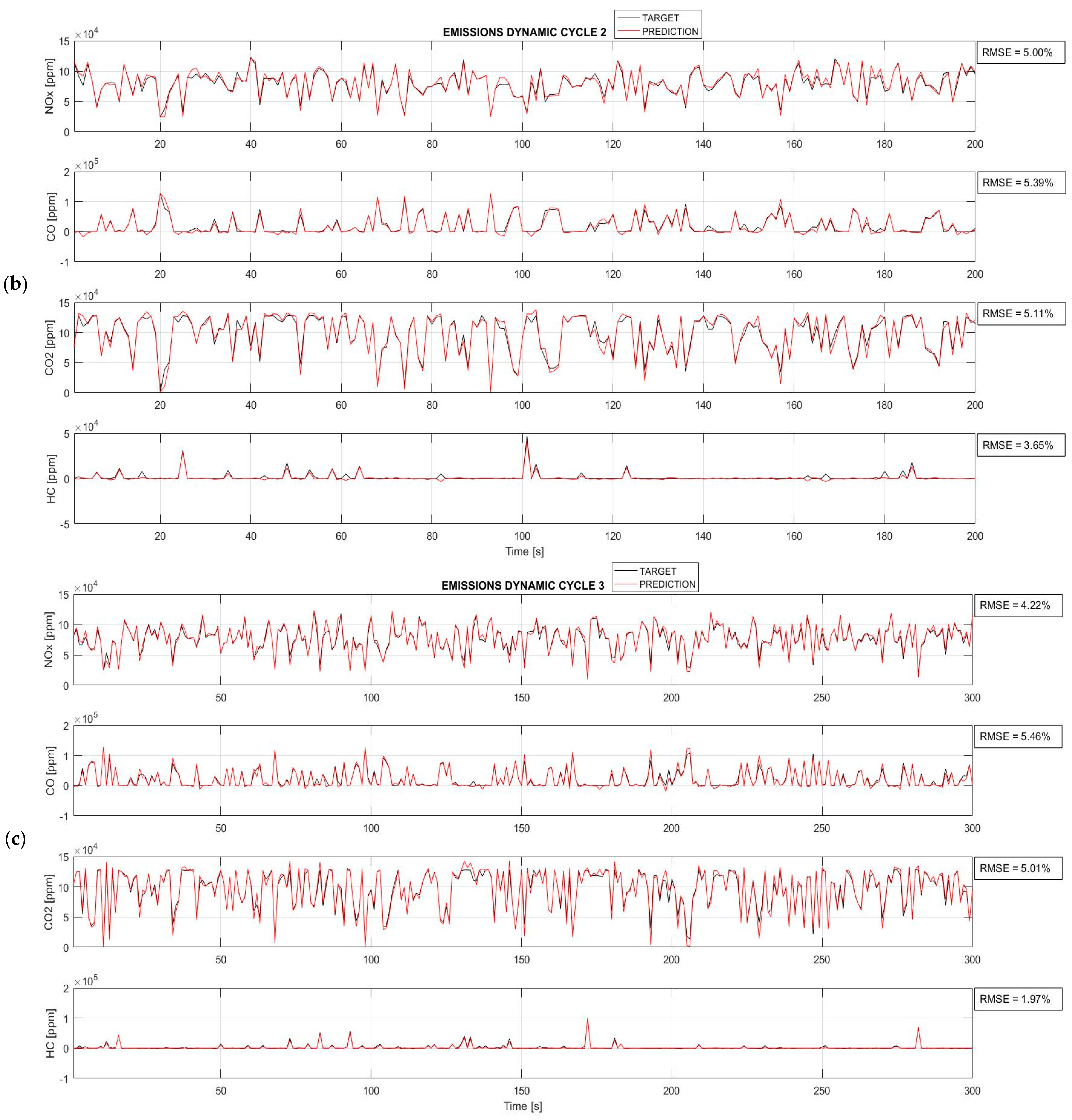
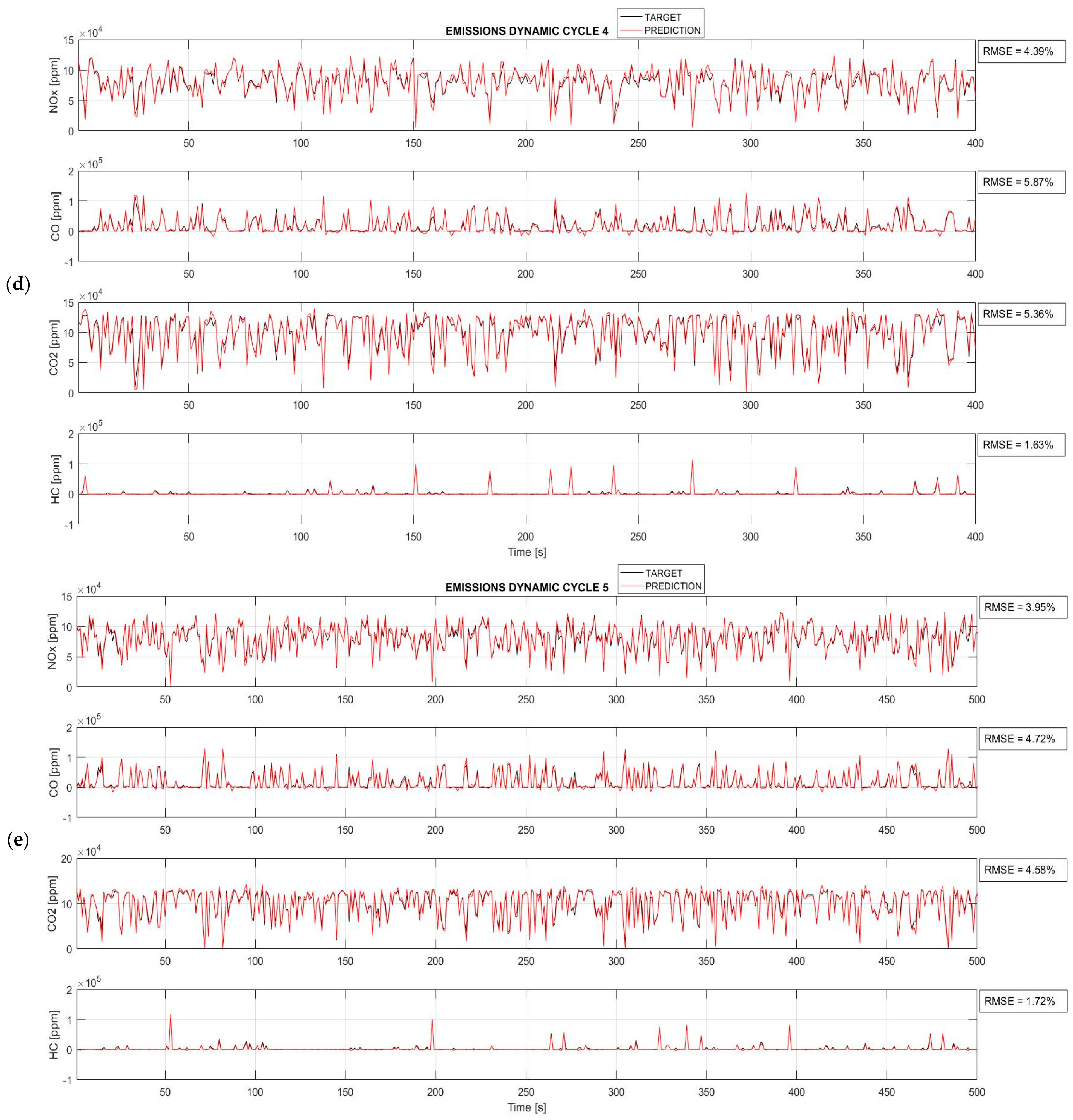
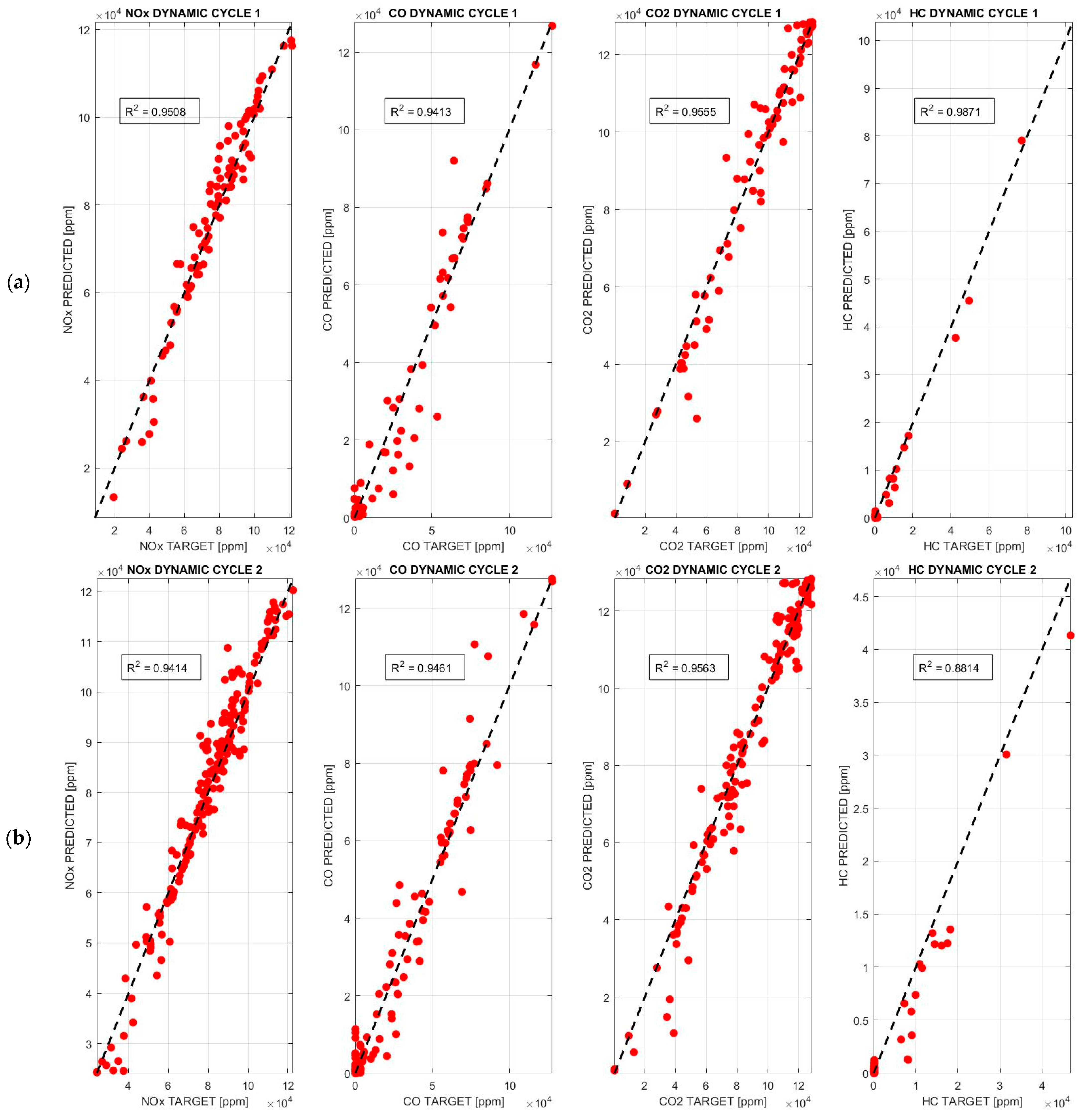
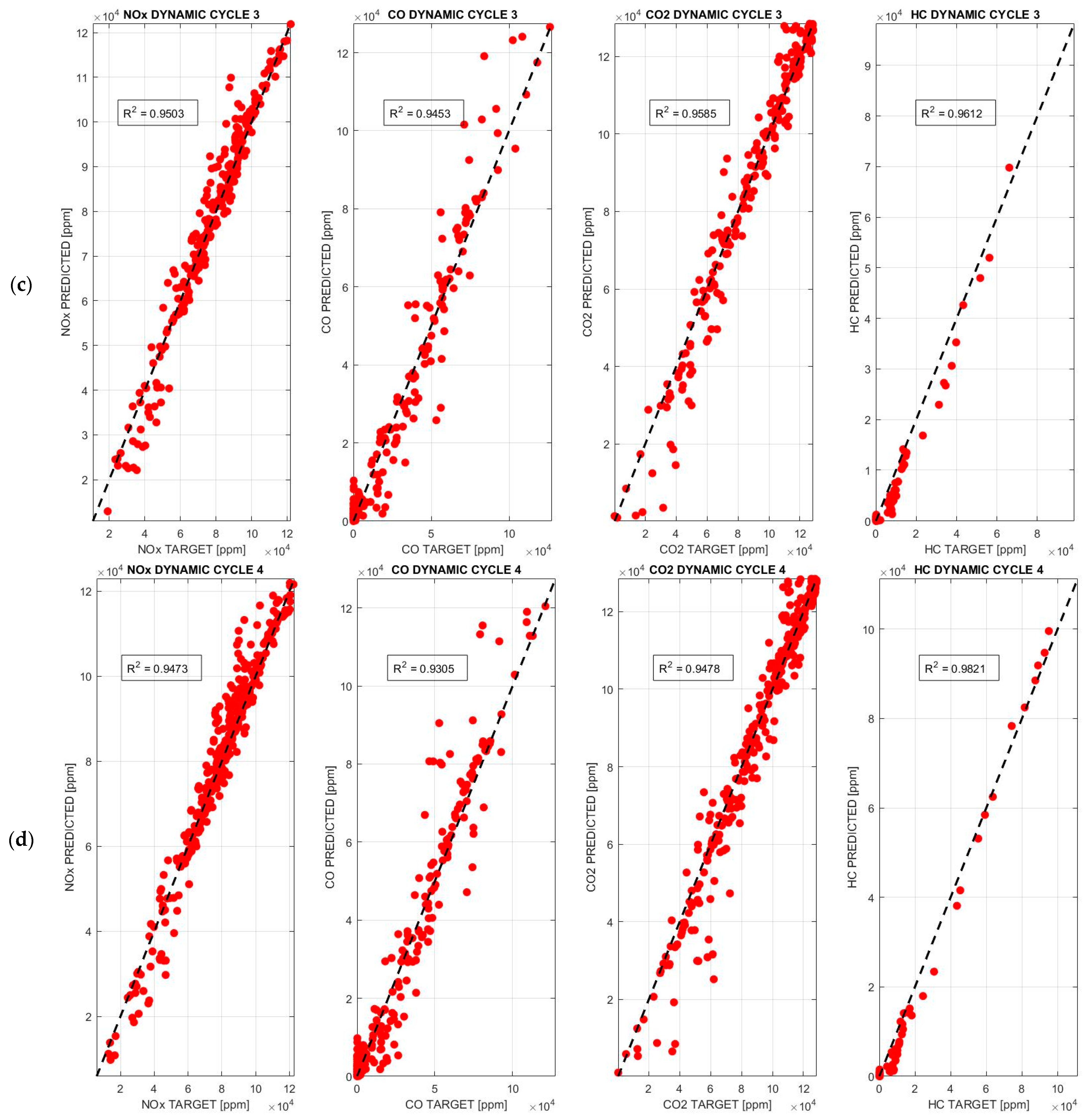
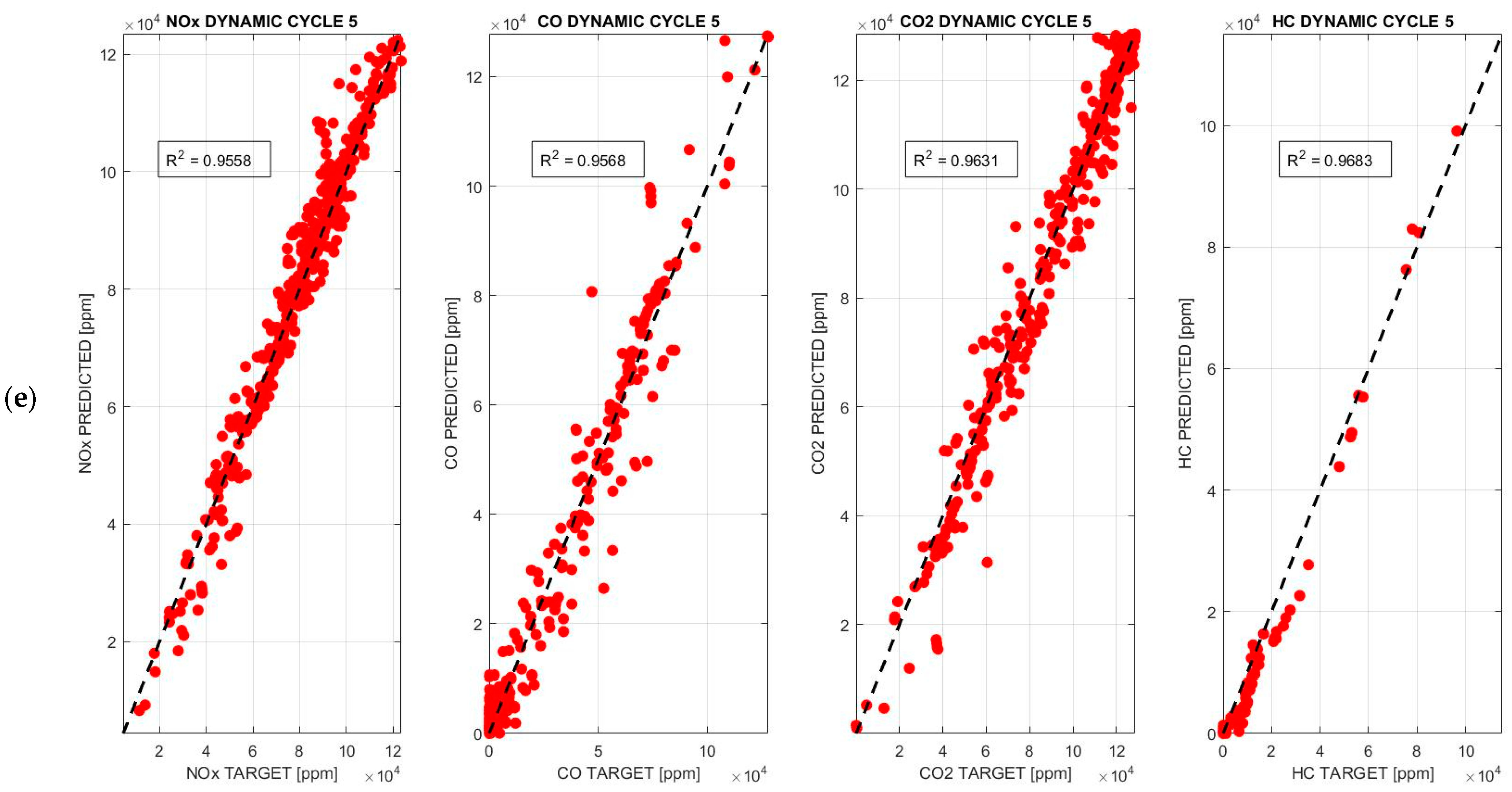
| Feature | Value | Unit |
|---|---|---|
| Displaced volume | 500 | cm3 |
| Stroke | 88 | mm |
| Bore | 85 | mm |
| Connecting rod length | 139 | mm |
| Compression ratio | 8.8:1 | - |
| Number of valves | 4 | - |
| Exhaust valve open | −13 | CAD aBDC |
| Exhaust valve closed | 25 | CAD aBDC |
| Intake valve open | −20 | CAD aBDC |
| Intake valve closed | −24 | CAD aBDC |
| Device | Description | Specifications |
|---|---|---|
| Kistler Kibox | Indicating analysis system for signal acquisition and combustion analysis | 10 analog input channels and 2 encoder input channels |
| Kistler 6061B | In-cylinder pressure piezoelectric sensor | Sensitivity: 25.9 pC/bar Range: 0–250 bar |
| Kistler 5011B | Charge amplifier | Scale: 10 bar/V |
| Kistler 4075A5 | Piezoresistive pressure sensor, used for the intake line, downstream of the throttle; reference for in-cylinder pressure pegging | Sensitivity: 25 mV/bar/mA Range: 0–5 bar |
| AVL 365C | Optical encoder for crankshaft angular position and engine speed measurement | Resolution up to 0.1 CAD |
| AVL 5700 | Dynamic brake, mechanically coupled with the engine crankshaft | Ensures the engine speed control through National Instruments hardware and in-house LabVIEW code |
| Athena GET HPUH4 | Engine control unit | Control the injector energizing time and IT by sending a trigger signal to the igniter control unit |
| Horiba Mexa 720 | Fast lambda probe | Output: AFR, λ, and [O2] Adjustable for various fuels through setting the O/C and H/C ratios |
| Horiba Mexa 7100D | Exhaust gas analyzer | Output: HC, CO, CO2, NOx, SO2, O2, and THC |
| Case Number [-] | Engine Speed [rpm] | IT [CAD aTDC] | TVO [%] | Torque [Nm] | NOx [ppm] | CO [ppm] | CO2 [ppm] | HC [ppm] |
|---|---|---|---|---|---|---|---|---|
| 1 | 500 | 38.3 | 10 | 9.63 | 3545.63 | 35.13 | 131,387.39 | 1.20 |
| 2 | 625 | 37.8 | 10 | 11.37 | 4121.68 | 26.74 | 126,021.47 | 1.21 |
| 3 | 750 | 38.5 | 10 | 12.62 | 4146.88 | 32.21 | 130,625.34 | 1.22 |
| . | . | . | . | . | . | . | . | . |
| . | . | . | . | . | . | . | . | . |
| . | . | . | . | . | . | . | . | . |
| 99 | 2000 | 22.8 | 100 | 36.50 | 4321.81 | 24.59 | 132,692.25 | 1.22 |
| 100 | 2250 | 4.0 | 100 | 28.04 | 1972.78 | 610.42 | 131,912.61 | 9.48 |
| Dynamic Cycle Number [-] | Duration [s] | RMSE NOx [%] | RMSE CO [%] | RMSE CO2 [%] | RMSE HC [%] |
|---|---|---|---|---|---|
| 1 | 100 | 4.29 | 5.65 | 5.27 | 1.57 |
| 2 | 200 | 5.00 | 5.39 | 5.11 | 3.65 |
| 3 | 300 | 4.22 | 5.46 | 5.01 | 1.97 |
| 4 | 400 | 4.39 | 5.87 | 5.36 | 1.63 |
| 5 | 500 | 3.95 | 4.72 | 4.58 | 1.72 |
| Dynamic Cycle Number [-] | Duration [s] | R2 NOx [-] | R2 CO [-] | R2 CO2 [-] | R2 HC [-] |
|---|---|---|---|---|---|
| 1 | 100 | 0.9508 | 0.9413 | 0.9555 | 0.9871 |
| 2 | 200 | 0.9414 | 0.9461 | 0.9563 | 0.8814 |
| 3 | 300 | 0.9503 | 0.9453 | 0.9585 | 0.9612 |
| 4 | 400 | 0.9473 | 0.9305 | 0.9478 | 0.9821 |
| 5 | 500 | 0.9558 | 0.9568 | 0.9631 | 0.9683 |
Disclaimer/Publisher’s Note: The statements, opinions and data contained in all publications are solely those of the individual author(s) and contributor(s) and not of MDPI and/or the editor(s). MDPI and/or the editor(s) disclaim responsibility for any injury to people or property resulting from any ideas, methods, instructions or products referred to in the content. |
© 2024 by the authors. Licensee MDPI, Basel, Switzerland. This article is an open access article distributed under the terms and conditions of the Creative Commons Attribution (CC BY) license (https://creativecommons.org/licenses/by/4.0/).
Share and Cite
Ricci, F.; Avana, M.; Mariani, F. A Deep Learning Method for the Prediction of Pollutant Emissions from Internal Combustion Engines. Appl. Sci. 2024, 14, 9707. https://doi.org/10.3390/app14219707
Ricci F, Avana M, Mariani F. A Deep Learning Method for the Prediction of Pollutant Emissions from Internal Combustion Engines. Applied Sciences. 2024; 14(21):9707. https://doi.org/10.3390/app14219707
Chicago/Turabian StyleRicci, Federico, Massimiliano Avana, and Francesco Mariani. 2024. "A Deep Learning Method for the Prediction of Pollutant Emissions from Internal Combustion Engines" Applied Sciences 14, no. 21: 9707. https://doi.org/10.3390/app14219707
APA StyleRicci, F., Avana, M., & Mariani, F. (2024). A Deep Learning Method for the Prediction of Pollutant Emissions from Internal Combustion Engines. Applied Sciences, 14(21), 9707. https://doi.org/10.3390/app14219707








